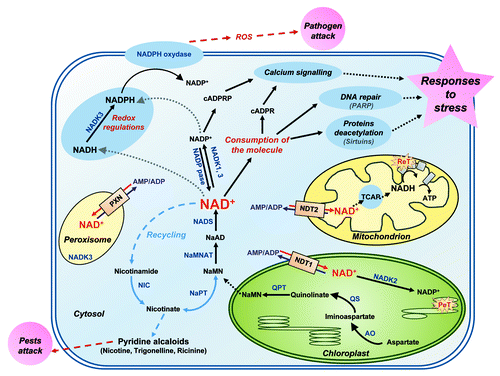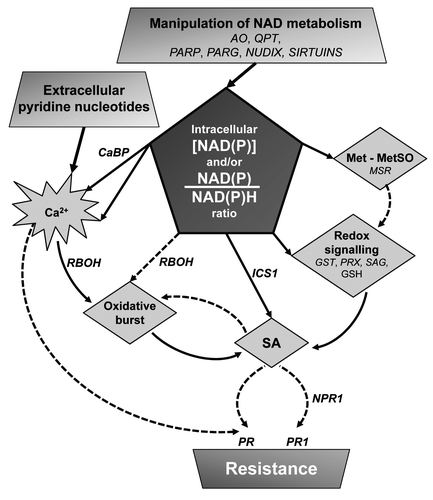Figures & data
Figure 1. Metabolism of nicotinamide adenine dinucleotide (NAD) in plants and its responses to stress. De novo biosynthesis, recycling, catabolism and utilization of the NAD+ molecule. Plain arrows indicate experimentally demonstrated reactions. Dashed arrows refer to condensed biochemical steps or experimentally non-demonstrated reactions. ADP: adenine diphosphate; AMP: adenine monophosphate; AO: aspartate oxidase; ATP: adenine triphosphate; cADPR(P): cyclic ADP-ribose (phospshate); ReT and PeT: respiratory and photosynthetic electron transport chains, respectively; NaAD: nicotinic acid adenine dinucleotide; NADK: NAD kinase; NADP: NAD phosphate; NADP pase: NADP phosphatase; NaMN: nicotinic acid mononucleotide; NaMNAT: NaMN adenylyltransferase; NADS: NAD synthetase; NaPT: nicotinate phosphoribosyltransferase; NDT: NAD+ carrier; NIC: nicotinamidase; PARP: poly-ADP-ribose polymerase; PXN: peroxisomal NAD carrier; QPT: quinolinate phosphoribosyltransferase; QS: quinolinate synthase; ROS: reactive oxygen species; TCAP: tricarboxylic acid pathway.

Table 1. Mutants and engineered plants used to illustrate the role of NAD in plant immunity
Figure 2. NAD, a key component of the plant immunity signaling network: a model. Manipulation of NAD biosynthesis (AO, QPT) or utilization (PARP; PARG; NUDIX hydrolases; SIRTUINS) alters redox balance of pyridine nucleotides (PNs) which interferes with plant defense responses. Modified pools of PNs induce calcium binding protein genes (CaBP)Citation18 and activate Ca2+ influx that stimulates NADPH oxidase (RBOH) activity therefore increasing ROS generation. Oxidative burst is believed to favor the signal amplification loop involving salicylic acid (SA).Citation2,Citation115 PNs also cause induction of SA-biosynthetic gene isochorismate synthase (ICS1) and lead to SA accumulation.Citation18 SA can activate pathogen-related (PR) genes by pathways that are dependent and independent of the non-repressor of PR1 (NPR1) component.Citation17 It remains unclear how Ca2+ triggers SA-dependent resistance. While it is not totally understood how PNs activate RBOH, the perturbation in NAD/P(H) pools disturbs redox signaling by inducing redox-related genes (glutathione S-transferase: GST; perodixase; PRX; senescence associated gene: SAG). Glutathione (GSH) which is regenerated by the reducing power of NADPH is also potentially altered by modified PNs levels. Another redox-related response upon high NAD content relies on the alteration of the methionine (Met) pools and the induction of Met sulfoxide reductase genes (MSR) that are involved in reducing Met sulfoxide residues (MetSO) back to Met.Citation18 Dashed arrows refer to possible signaling connections.
